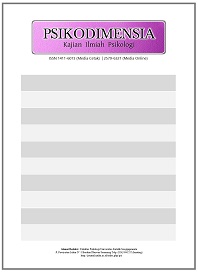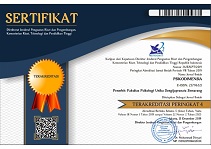Peran Determinan The Investment Model terhadap Komitmen pada Suami/Istri yang Pernah Mengalami Transgressions dari Pasangan
Abstract
Keywords
Full Text:
PDF (Bahasa Indonesia)References
Anderson, S. A. & Sabatelli, R. M. (2011). Family Interaction: A Multigenerational Developmental Perspective. United States of America: Pearson Education, Inc.
Atmaja, T. P. & Handoyo, P. (2014). Eksistensi Survivor Perempuan Eks Korban Kekerasan dalam Rumah Tangga (KDRT) Pada Komunitas Sekar Arum Kabupaten Jombang. Paradigman, 2 (1), 1-10.
Berk, Laura E. (2014). Exploring LifeSpan Development. United States of America: Pearson Education, Inc
Braithwaite, Scott R. & Selby, Edward A. (2011). Forgiveness and Relationship Satisfaction: Mediating Mechanisms. Journal of Family Psychology, 25 (4), 551-559. https://doi.org/10.1037/a0024526
Brehm, S. S., Miller, R. S., Perlman, D., & Campbell, S. M. (2002). Intimate Relationship, Third Edition. New York: McGraw-Hill.
Edwina, I. P., Megarini, Y., & Maria, C. (2018). The Investment Model pada Pasangan Suami Istri di Kota Bandung. Simposium Nasional Psikologi Positif, 26-31.
Fauzi, M. (2018). Diktat Mata Kuliah Psikologi Keluarga. Tangerang: PSP Nusantara Press.
Feldman, R. S. (2018). Development Across the LifeSpan, 8th Edition. England: Pearson Education.
Finkel, E. J., Rusbult, C. E., Kumashiro, M., & Hannon, P. E. (2002). Dealing with Betrayal in Close Relationships: Does Commitment Promote Forgiveness. Journal of Personality and Social Psychology, 82 (6), 956-974. https://doi.org/10.1037/0022-3514.82.6.956
Gordon, dkk. (2009). Widening Spheres of Impact: The Role of Forgiveness in Marital and Family Functioning. Journal of Family Psychology, 23 (1), 1-13. https://doi.org/10.1037a0014354
Harvey, J. H. & Wenzel, A. (2001). Close Romantic Relationships Maintenance and Enhancement. New Jersey: Lawrence Erlbaum Associates.
Impett, E. A., Beals, K. P., & Peplau, L. A. (2001). Testing the Investment Model of Relationship Commitment and Stability in a Longitudinal Study of Married Couples. Current Psychology, 20 (4), 312–326. https://doi.org/10.1007/s12144-001-1014-3
Jhamb, S. & Singh, P. (2020). Long Term Marriages and the Psychology Behind Them. International Journal of Science and Research, 9 (7), 1846- 1854. https://doi.org/10.21275/SR20724201828
Juhari, R. & Arif, N. A. M. (2016). Investment Model of Marital Commitment Among Urban Dual-Earner Couples. Journal of Education and Social Sciences, 5 (2), 170-174. https://doi.org/10.7454/proust.v1i2.36
Lin, Yuan-Hei W. & Rusbult, C. E. (1995). Commitment to Dating Relationships and Cross-Sex Friendships in America and China. Journal of Social and Personal Relationships, 12 (1), 7-26. https://doi.org/10/1177/0265407595121001
Maria, C., & Andamari, S. (2019). Perbandingan Komitmen Perkawinan antara Laki-Laki dan Perempuan yang sudah Menikah di Bandung. Humanitas, 3 (3), 259-275. https://doi.org/10.28932/humanitas.v3i3.2273
McCullough, M. E., Rachal, K. C., & Worthington, E. L. (1997) Interpersonal Forgiving in Close Relationship. Journal of Personality and Social Psychology, 73 (2), 321-336. https://doi.org/10.1037/0022-3514.73.2.321
Olson, D. H., DeFrain J., & Skogrand, L. (2019). Marriage and Families: Intimacy, Diversity, and Strengths, Ninth Edition. New York: McGraw-Hill Education.
Roloff, M. E., Soule, K. P., & Carey, C. M. (2001). Reasons for Remaining in a Relationship and Responses to Relational Transgressions. Journal of Social and Personal Relationships, 18 (3), 362-385. https://doi.org/10.1177/0265407501183004
Rusbult, C. E. (1983). A Longitudinal Test of The Investment Model: The Development (and Deterioration) of Satisfaction and Commitment in Heterosexual Involvements. Journal of Personality and Social Psychology, 45 (1), 101-117. https://doi.org/10.1037/0022-3514.45.1.101
Rusbult, C. E. & Martz, J. M. (1995). Remaining in an Abusive Relationship: An Investment Model Analysis of Nonvoluntary Dependence. The Society for Personality and Social Psychology, Inc, 21(6), 558-571. https://doi.org/10.1177/0146167295216002
Rusbult, C. E., Agnew, C., & Arriaga X. B. (2011). The Investment Model of Commitment Processes. Dalam P. A. M. Van Lange, A. W. Kruglanski, & E. T. Higgins (Eds.), Handbook of Theories of Social Psychology, 218-231. Sage Publication Ltd.
Rusbult, C. E., Martz, J. M., & Agnew, C. R. (1998). The Investment Model Scale: Measuring Commitment Level, Satisfaction Level, Quality of Alternatives, and Investment Size. Personal Relationships, 5, 357-391. https://doi.org/10.1111/j.1475-6811.1998.tb00177.x
Sheldon, P. & Antony, M. G. (2019). Forgive and Forget: A Typology of Transgressions and Forgiveness Strategies in Married and Dating Relationships. Journal of Communication, 1-20. https://doi.org/10.1080/10570314.2018.1504981
Stanley, S. M., Rhoades, G. K., & Whitton, S. W. (2010). Commitment: Functions, Formation, and the Securing of Romantic Attachment. Journal of Family Theory & Review, 243-257. https://doi.org/10.1111/j.1756-2589.2010.00060.x
Strelan, P., Karremans, J. C., & Krieg, J. (2016). What Determines Forgiveness in Close Relationships: The Role of Post-Transgression Trust. The British Psychological Society. https://doi.org/10.1111/bjjso.12173
Wulandari, D. A. (2009). Kajian Tentang Faktor-Faktor Komitmen dalam Perkawinan. Psycho Idea, 7 (1), 1-10. https://doi.org/10.30595/psychoidea.v7i1.168
DOI: https://doi.org/10.24167/psidim.v23i1.10418
Print ISSN : 1411-6073 | online ISSN : 2579-6321 View My Stats

This work is licensed under a Creative Commons Attribution 4.0 International License.




















